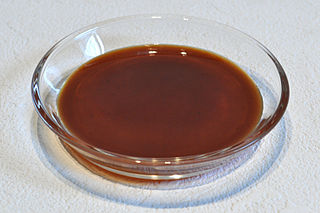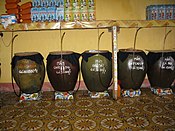
Worcestershire sauce or Worcester sauce is a fermented liquid condiment invented by pharmacists John Wheeley Lea and William Henry Perrins in the city of Worcester in Worcestershire, England, during the first half of the 19th century. The inventors went on to form the company Lea & Perrins.

Fish sauce is a liquid condiment made from fish or krill that have been coated in salt and fermented for up to two years. It is used as a staple seasoning in East Asian cuisine and Southeast Asian cuisine, particularly Myanmar, Cambodia, Laos, Philippines, Thailand, and Vietnam. Some garum-related fish sauces have been used in the West since the Roman times.

Garum is a fermented fish sauce that was used as a condiment in the cuisines of Phoenicia, ancient Greece, Rome, Carthage and later Byzantium. Liquamen is a similar preparation, and at times they were synonymous. Although garum enjoyed its greatest popularity in the Western Mediterranean and the Roman world, it was earlier used by the Greeks. The taste of garum is thought to be comparable to that of today's Asian fish sauces.

Prahok is a salted and fermented fish paste used in Cambodian cuisine as a seasoning or a condiment. It originated as a way of preserving fish during the months when fresh fish was not available in abundant supply. Because of its saltiness and strong flavor, it was used as an addition to many meals in Cambodian cuisine, such as soups and sauces. A Cambodian saying goes, "No prahok, no salt", referring to a dish that is of poor flavor or bland thus highlighting its essentiality in Cambodian cuisine.

Fish paste is fish which has been chemically broken down by a fermentation process until it reaches the consistency of a soft creamy purée or paste. Alternatively it refers to cooked fish that has been physically broken down by pounding, grinding, pressing, mincing, blending, and/or sieving, until it reaches the consistency of paste. The term can be applied also to shellfish pastes, such as shrimp paste or crab paste.

Bagoóng is a Philippine condiment partially or completely made of either fermented fish or krill or shrimp paste with salt. The fermentation process also produces fish sauce known as patís.

Shrimp paste or prawn sauce is a fermented condiment commonly used in Southeast Asian and Coastal Chinese cuisines. It is primarily made from finely crushed shrimp or krill mixed with salt, and then fermented for several weeks. They are either sold in their wet form or are sun-dried and either cut into rectangular blocks or sold in bulk. It is an essential ingredient in many curries, sauces and sambal. Shrimp paste can be found in many meals in Cambodia, Indonesia, Laos, Malaysia, Myanmar, the Philippines, Singapore, Thailand, and Vietnam. It is often an ingredient in dip for fish or vegetables.

The generic term for condiments in the Filipino cuisine is sawsawan. Unlike sauces in other Southeast Asian regions, most sawsawan are not prepared beforehand, but are assembled on the table according to the preferences of the diner.

Bagoong monamon, bagoong monamon-dilis, or simply bagoong and bugguong munamon in Ilocano, is a common ingredient used in the Philippines and particularly in Northern Ilocano cuisine. It is made by fermenting salted anchovies which is not designed, nor customarily used for immediate consumption since it is completely raw.

Pla ra, similar to padaek in Laos, is a traditional Thai seasoning produced by fermenting fish with rice bran or roasted rice flour and salt fermented in a closed container for at least six months. Fermented fish seasoning are commonly found in Cambodian, Lao, Mon, Thai and Vietnamese cuisine. Pla ra has a very strong smell, which is considered unpleasant by some people. Its flavors are salty and sour, depending on the amount of salt put in and lactic acid resulting from fermentation process.

Padaek or padek is a traditional Lao condiment made from pickled or fermented fish that has been cured. It often contains chunks of fish and is thicker, as well as more seasoned than fish sauce. The fermentation takes a long time, giving padaek an aroma similar to cheeses like Époisses. Unlike other versions of fish sauce in Southeast Asia, padaek is made from freshwater fish, owing to the landlocked nature of the former kingdom of Lan Xang. Padaek is used in many Lao dishes, most notably tam maak hoong.

Phu Quoc fish sauce is a variety of fish sauce in Vietnamese cuisine made from fermented black anchovies. It is produced in Phu Quoc island in southwest Vietnam and the 21 islets surrounding it. Traditional production dates back centuries.

Anchovies are small, common saltwater forage fish in the family Engraulidae that are used as human food and fish bait. There are 144 species in 17 genera found in the Atlantic, Indian, and Pacific Oceans. Anchovies are usually classified as oily fish. They are small, green fish with blue reflections due to a silver longitudinal stripe that runs from the base of the caudal fin. They range from 2 centimetres (0.79 in) to 40 centimetres (16 in) in adult length, and the body shape is variable, with more slender fish in northern populations.

Mắm nêm is a sauce made of fermented fish. Unlike the more familiar nước mắm, mắm nêm is powerfully pungent, similar to shrimp paste. Many of the regions that produce fish sauce, for example Central Vietnam, also produce mắm nêm. It is commonly mixed with sugar, pineapple, and spices to make a prepared sauce called mắm nêm pha sẵn, the key ingredient in neem sauce.

Anchovy paste is a fish paste food product prepared using anchovies as a primary ingredient. It is used as a condiment and as an ingredient in various dishes, such as Scotch woodcock, and is a mass-produced product. It has been used for centuries to provide flavor to foods and as a source of nutrients, and it is a part of the cuisines of Great Britain, Italy, the Philippines and Vietnam. It is a major export product of Morocco.

Red Boat is a brand of premium Phu Quoc fish sauce.



























